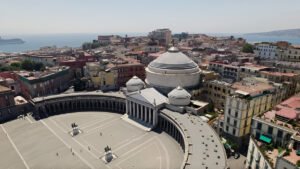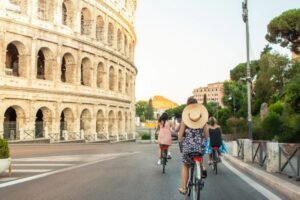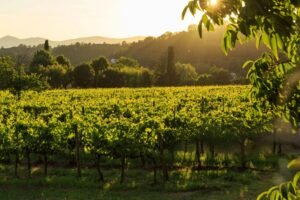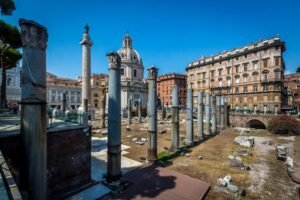10 best wineries in Tuscany | discover the top picks.
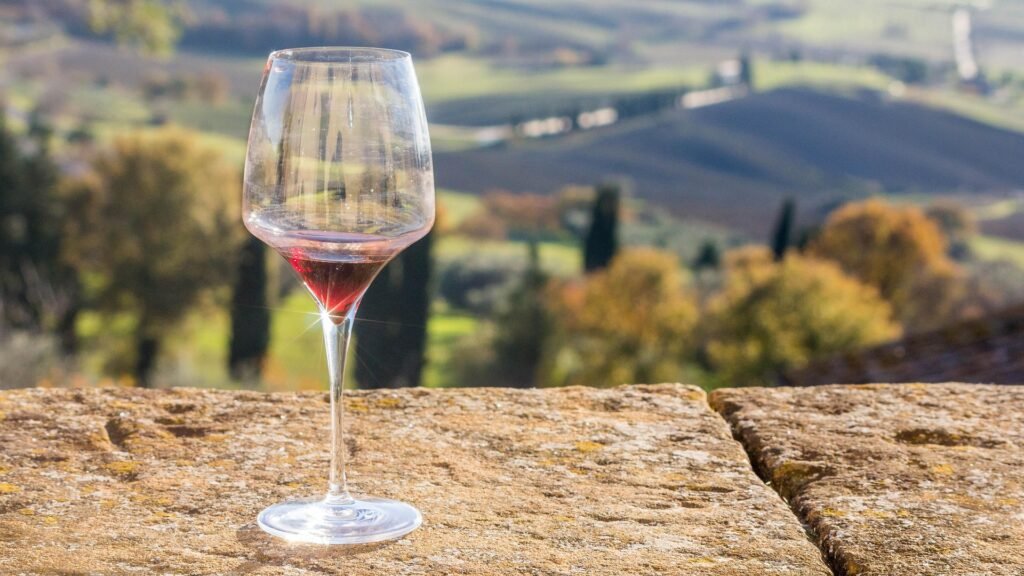
Table of Contents
Tuscany is one of my favorite places to visit in the entire world. It’s a dream destination where rolling hills, sun-soaked vineyards, and medieval villages transport you to another time. I just returned home from a visit there, and there’s nothing quite like enjoying world-class wines while overlooking vineyards, olive groves, and Italian cypress-lined roads.
In this Blog, I’m going to share 10 of my favorite wineries to visit in Chianti Classico, which is a short 45-minute drive from Florence and one of my favorite places to visit in Tuscany. Of course, even if you’re not going to Tuscany anytime soon, this blog will still be very useful for you, as I’m going to share my thoughts regarding the wines produced by these wineries, many of which are strong buys and which I buy for my own cellar located in Gaiole in Chianti, more than 500 meters above sea level.
Castell’AMA
Castell’AMA is situated on extremely rocky soils. These rocky soils and high-elevation vineyards combine to produce challenging conditions for grapes to grow, and the result is naturally low yields and wines with intensity and concentration that are some of the most enjoyable wines in all of Chianti Classico. This is also a fantastic place to visit if you’re a fan of art, as they have contemporary artwork displayed throughout the entire estate. When you tour the estate, you get to see all of the various pieces of art created by top artists. Castell’AMA encourages artists to visit, and many of those artists are inspired during their visit and produce works of art that remain on the property after they leave.
Castello di AMA rebuilt its primary winery building a few years ago, and this is where it hosts most of the tastings. The building itself is like a work of art; it’s built primarily with many of the stones that are found all over the property. They also have several sections with floor-to-ceiling glass that provides breathtaking views of the stunning scenery below.
Castell’AMA also has a hospitality group, so you can stay there as well. Of course, in addition to touring the winery and estate, you’ll have the opportunity to do a wine tasting, and I found the lineup to be extremely strong from start to finish. In fact, one of the wines, namely the Castello di San Lorenzo Chianti Classico Gran Selezione, was one of my favorite wines from the entire trip.
Located in Panzano in Chianti, Fènt’s vineyards are situated in an area referred to as Concadoro, or the Golden Shell. This area is widely considered to be among the very best places in all of Chianti Classico for the production of high-quality, collectible wine.
Fontodi
Fontodi has 130 hectares on their estate, 70 of which are planted to vine. Fontodi also raises cattle on its estate—this is the famous breed of cattle used to produce the Bistecca alla Fiorentina, the famous cut of beef you can enjoy when you’re in Florence at a restaurant. In addition, Fontodi uses the manure from these cattle for preparations in the vineyard. Fontodi is a big proponent of organic and biodynamic practices, both in the vineyard and in the winery. During your visit to Fontodi, you can expect a comprehensive tour of the winery, including the barrel room and the production facility.
As well as enjoying stunning aerial views of Concadoro and the vineyards below, I’ve been fortunate that during both of my visits to Fontodi, the winery was bustling with activity. Last November, when I was there, they were bottling the Via del Sorbo, which is an outstanding Chianti Classico Gran Selezione. Last week, when I was there, they were harvesting the fruit for the Flaccianello for the 2024 vintage and also sorting that fruit, de-stemming it, and beginning the fermentation for that wine. The Flaccianello is the top wine produced by Fontodi and definitely the most coveted by collectors. This is an extraordinarily age-worthy wine, and it’s definitely one I highly recommend you try if you haven’t already.
Following your tour, you’ll enjoy a wine tasting, which is certainly a real treat, as all the wines produced by Fontodi are of extremely high quality. In addition to the Flaccianello I discussed earlier, you’ll most likely get a chance to taste their Chianti Classico, which is their most widely produced wine. If you haven’t yet tried a wine from Fontodi, I highly recommend the Chianti Classico, a wine that sells for a very fair price for its quality. It’s also an extremely age-worthy wine; we enjoyed a 2010 vintage last week that was still showing extremely well.
Il Molino di Grace
Il Molino di Grace As long as we’re talking about Fontodi in Panzano, we should also talk about Il Molino di Grace, which is located very close by. The first time I visited Chianti Classico, my driver suggested that, on the way to Fontodi, we do a quick stop at Il Molino di Grace as well. Since we were ahead of schedule, I didn’t have an appointment at Il Molino di Grace and just stopped in cold off the street.
They had no idea who I was, but they nevertheless accommodated me and were extremely gracious, letting us taste through the entire lineup, which was quite impressive. Il Molino di Grace has around 20 hectares of vines and is located in a prime wine-producing area that’s been used to produce wine in the Chianti Classico region for more than 350 years. I particularly enjoy their Chianti Classico.
Lamai de Lamai Grand Selezione
Lamai de Lamai Grand Selezione, as well as the Vin Santo, so definitely, if you’re on your way to Fontodi, be sure to stop by Il Molino di Grace as well. The aptly named Lamai de Lamai is located in Lamai, a high-altitude hamlet in the municipality of Greve in Chianti. The drive up to Lamai de Lamai is absolutely stunning, with incredible scenery. It’s also quite rugged, and I spotted a baby wild boar (or cinghiale) on the drive up, but unfortunately, I wasn’t quick enough to get a picture. Lamai has some vineyards located at the extreme upper limit for the production of Sangiovese in Chianti Classico, with vineyards at more than 650 meters above sea level.
The vineyard tour at Lamai de Lamai was definitely one of the highlights, given the extreme high elevation, the stunning views of the scenery below, as well as the terraced vineyards and some of the old bush vines that date back more than 60 or 70 years. In addition, I happened to be there during harvest, so they gave me some gloves, pruning shears, and a bucket, and taught me how to harvest some Sangiovese manually.
The perfectly ripe Sangiovese bunches that I harvested are going to be used in the 2024 Lamai de Lamai Chianti Classico. Following the vineyard tour and the lessons on manual harvesting, we also toured the winery and saw the barrel room and the wine production facility, including some of the historic aged bottles in the library, one of which dates back to the 1920s. After the tour of the winery, we went to the Lamai restaurant, which is just a short drive away, where we had an incredible multi-course lunch.
Paired perfectly with a number of the outstanding Lamai wines. So, when you visit Lamai de Lamai, I highly recommend timing your visit so that you’ll be able to have lunch or dinner at their outstanding restaurant.
Castello di Monsanto
Castello di Monsanto is a family-owned and operated winery that was founded back in the early 1960s. It is located in San Donato in Poggio, and they have 72 hectares of vineyards situated between 280 and 320 meters above sea level. When you arrive, you’ll be greeted by a very friendly and well-trained winery dog, and you’ll also immediately be impressed by the formal gardens, which include an impressive fountain.
The vineyard tour will give you an appreciation for just how rocky the soils in Chianti Classico can be. But for me, the highlight of the visit to Castello di Monsanto was definitely the tour of the extensive cave network. This cave network provides ideal conditions for Monsanto to mature their wines, but they also use it to house their extensive collection of library wines. Monsanto is one of the very few producers in Chianti Classico that has an extensive collection of library wines, so if you’re someone who’s interested in acquiring rare year vintages, for example, you may want to give them a call.
Their most iconic wine is the Castello di Monsanto Ilio Chianti Classico Gran Selezione. This is an extraordinarily age-worthy wine and one that’s been produced every vintage since 1962. During my visit, I was able to try some very old vintages of this wine that were still quite impressive, including the 1972, 1978, 1998, and 2017 vintages. But the wine I enjoy most frequently from Castello di Monsanto is their outstanding Chianti Classico Riserva, which is always an exceptional value and a wine I buy with confidence pretty much year in and year out.
If you’re interested in wine recommendations, wine collecting strategies, and learning more about wine, please do subscribe to my channel. I’ve been collecting wine for more than 15 years and also have a Level 4 Diploma from the WSET, so I have both formal certification as well as substantial practical knowledge from the School of Hard Knocks.
Castello di Vaya
Located in Radda in Chianti, Castello di Vaya has 45 hectares of vineyards in Chianti Classico that are planted at about 400 meters above sea level, which feature the famous Gesso soils. Gesso soils are soils that include crumbly sandstone, clay, and marl. These conditions help to produce refined, elegant Sangiovese with impressive aromatics. Vaya is a self-contained ancient village surrounded by walls, and the winery is located within historic buildings that are included inside the walls.
Ancient walls. Notably, however, the winemaking equipment is modern and state-of-the-art, which is quite a surprise once you enter these historic buildings. Vaya also has rooms and villas to rent and a highly acclaimed restaurant as well. I’ve recommended the Vaya wines on this channel on many other occasions, so I’m not going to go into too much detail about the wines in this blog, but suffice it to say that the entire lineup is impressive.
Barone Ricasoli
Next up is Barone Ricasoli. While Barone Ricasoli has a tasting area in Gaiole in Chianti, I strongly recommend that you go to Castello di Brolio and taste there instead. Castello di Brolio is, in itself, a historic attraction and well worth a visit. In fact, TripAdvisor rates Castello di Brolio as one of the top 10 tourist destinations in the entire world. This property has an interesting backstory, as the Ricasoli family acquired it hundreds of years ago due to an alliance of sorts with the Medici in Florence, and this property has ideal vantage points to keep an eye on Siena, which is clearly visible in the distance.
During my visit, we were able to taste through an impressive lineup of eight or nine wines in what was described as the Castello’s small dining room, which, as a practical matter, was an incredibly large, ornate, and lavishly decorated dining room that featured stunning views of the grounds below. Following the tasting at the Castello, we went to lunch at the winery’s nearby restaurant. While it looks like a treehouse from the outside, this is actually a serious restaurant that offers upscale cuisine with outstanding presentation. There, we were also able to try a number of additional wines from this producer, including an impressive Trebbiano that was a white wine quite refreshing, as well as one of the most enjoyable Vin Santo wines I had last week.
Castello di Emma
Like Monsanto that I discussed earlier in this blog, Castello di Emma is located in San Donato in Poggio. The winery is situated right in the middle of the vineyards, so as you pull up, you’ll be able to get a nice view of the vineyards as well as the extremely rocky soils.
That feature some of the famous alberese soils. Casma is a big proponent of organic and biodynamic practices. Interestingly, they actually use a flock of domestic geese to help work the vineyards. I asked why they use geese rather than sheep, and they said it’s because, unlike sheep, geese do not eat the grapes. However, the geese help control harmful insects and the weed population, and they also fertilize the vineyards.
Based on my tour of the winery and the barrel room, I discovered that Casa Emma places an emphasis on neutral oak and even amphorae to mature their wines. Following the tour, we did a tasting, and it was interesting because you were able to compare wines matured in neutral oak on the one hand, and they even had a separate bottling that was matured exclusively in amphorae, so you could compare the wines and see the impact that the different maturation vessels have on those wines.
As much as I enjoyed the Chianti Classico wine lineup, it was a Merlot that was probably the most impressive wine I tasted at Casa Emma. Somewhat unusually, they grow their Merlot in rocky soils rather than clay soils, which is customary. The result was a Merlot that stood out for its abundant acidity and freshness.
When I’m planning my wine trips to different wine regions, I try to include a variety of visits so that my experiences are not all duplicative and the same. This means that while I certainly try to include some visits to well-established producers with big names, I also make it a point to visit at least one smaller family-owned winery during each trip.
Pomona
Of my trips, last week’s visit to Chianti Classico was to Pomona, a small family-owned producer that I visited. Pomona is located in Castellina in Chianti and has around six to seven hectares of vineyard. We were able to get an extensive vineyard tour with the owner, Monica Raspi. We must have walked at least three or four of the hectares of the vineyards because we were walking for probably 45 minutes to an hour. But it was good that we did because we were able to get a really good sense of the different growing conditions in terms of aspect and the type of soil that exists, even within the span of just a few hectares.
In fact, the Pomona vineyards also span two different UGAs, so you’re able to get a rare opportunity to compare wines from two different UGAs that are otherwise made in the exact same manner. It was absolutely fascinating to do this tasting comparison and see how different these wines could be despite the fact that the vineyards were so close together and made in the exact same way.
Pomona’s approach to winemaking emphasizes approachability and affordability. The wines are all matured in either neutral oak or stainless steel. As such, they’re quite food-friendly and approachable, even in their youth.
Castello di Vió Maggio
If you’re looking for not just a winery to visit for a tasting but also a place to stay, another winery you’d want to consider is Castello di Vió Maggio, which is located in Greve in Chianti. Castello di Vió Maggio has a number of rooms and villas available for rent. They also have an on-site restaurant in addition to the winery, so you can dine there and also get your winery tour in.
Better still, they have an infinity-edge pool, and the views from the patio and the pool are absolutely stunning. Castello Vió Maggio also conducts a number of weddings on their property, so if that’s something you’re looking for, you definitely want to give them some consideration. The wines at Castello Vió Maggio were also enjoyable. I particularly enjoyed the comparison of their Gran Selezione.
If you’d like to learn more about Chianti Classico and why I think this region has some of the most promising wines that will only continue to get better in quality, be sure to check out this blog that’s linked above, where I do a Chianti Classico deep dive.
Thank you, and that wraps up 10 best wineries in Tuscany | discover the top picks. Do you agree with the places we chose, or is there somewhere you visited that you feel should be on the list? leave us a comment.
You can find me on Instagram: @dreamytravelersofficial/.


